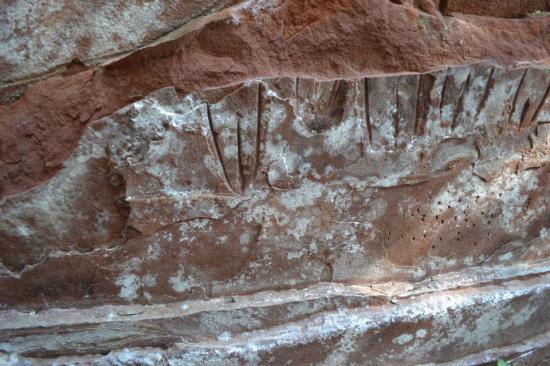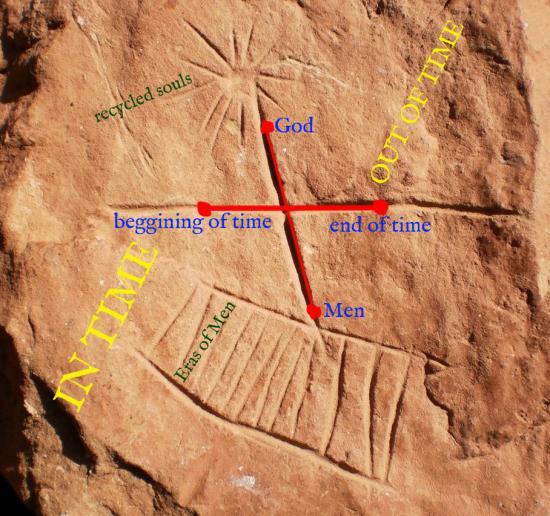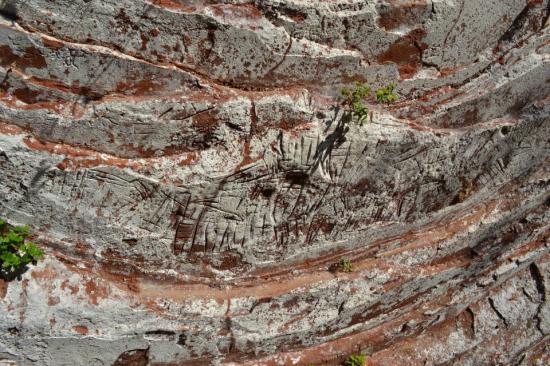Source - http://www.pasthorizonspr.com/index.php/archives/01/2013/the-solar-map-project-recording-the-ita-letra
VIDEO = http://www.kickstarter.com/projects/frankweaver/explore-ancient-rock-art-experience-guarani-cultur?ref=card
Enigmatic petroglyphs, once hidden deep within the Paraguayan jungle are a testament to the people of the Amambay hills. However, as the jungle is increasingly torn down and the trees set alight by slash and burn farmers, the rock-art is disappearing at an alarming rate.
To the local Pai Tavytera Indians the Amambay hills are sacred and the mysterious carvings found within the many caves and rock-shelters play an important role in their spiritual life.

Sun setting on the Amambay hills. Image: Frank Weaver
Under threat
Much of the rock-art has survived unscathed for many generations as the fortress like hills and dense jungle offered protection from the outside world. Although Paraguay contains pockets of rock-art throughout the country, this area appears to have produced a remarkable concentration from pre-historic times to more recent contact period.
However, because of the increase in vandalism, decay, fire damage and treasure hunting, Frank Weaver, a documentary maker and environmentalist has decided that the time is right to bring this unique rock-art to a world audience and at the same time heighten awareness of the plight of the Indians and help keep their culture alive.

Once the protection from the shade of trees is removed, the sun rays blast the shelters, causing fungus to grow. THe fungus then breaks the rock where the ancient inscriptions resides .Image: Frank Weaver
A deep connection
Frank was born and raised in Amambay and became involved with the local tribes in the 1980s while volunteering alongside his father and grandmother, leaders of one of the first environmental NGOs in Paraguay. Their projects aimed to help maintain the rain forest and reforest parts of the Indian reservations devastated by land clearing and poor conservation.
Frank explained, “after a while the Indians allowed us to visit their sacred engravings which they call “Ita letra”, or the written stone.”
“I have always had a passion for video,” Frank continued, “so during my visits to Paraguay I started recording tribal traditions.”
“From the first moment I caught sight of the rock-art, my dream was to capture it in a documentary in order to show it to the world and highlight the story of the Indians and their plight.”
He added, “assimilation into Paraguayan culture has been difficult for them, frequently ending in either alcoholism or suicide, and many who leave the reservations for city life find themselves living in cardboard shacks on the side of highways.”

Don Galeano Suarez a Shaman of the Panambi’y tribe. Image: Frank Weaver
Working with spiritual leaders
Frank, through his connections with the local Panambi’y people is working with their shamans and spiritual leaders in order to document their creation mythology, ancestor stories and religious practices, in the hope of gaining some insight into the rock-carvings.
Solar Map
The idea for his project was inspired by a “solar map” which was carved at some point in the past into a sandstone boulder, within a rock-shelter. This carving , now protected in a museum, depicts a cross shape with a sun above it. According to one of the Panambi’y shamans the cross is actually a much older symbol used by the Indians. However, after conversion they chose to keep the symbol of their belief disguised as Christianity. Using a photograph of the solar map the shaman then attempted to explain his people’s belief system.

Solar Map. Image: Frank Weaver
“The horizontal line of the cross is actually a type of horizon, that divides heaven and earth, but also its a line of time, from the beginning to the end. The vertical line is the link between God and man, where God lives outside of time in heaven, and man lives inside time on earth. Man’s soul must have a good connection with God, if not, upon death the soul gets recycled.”
“The shaman then went on to explain that the section on the solar map at the bottom of the cross represents the different eras of man.”
Frank hopes to interweave interviews like this one from the shaman into his final documentary piece that he intends to film in the coming months.
Bridging both prehistoric and historic periods
Rock art specialist Dr. George Nash from Bristol University in southwest England pointed out that the tooling method used to created the Solar Map means that it probably dates from the historic period, explaining;
“We see (elsewhere in South America) contact with Europeans (AD 1500 onwards). However, the first metalwork in South America occurs around 2300 BCE (with possible evidence to 8000 BCE), but this is occurring in the main power centres of Central America. In Paraguay a different social system is occurring – native indigenous peoples who live in forested areas. The metalwork concept would have probably come much later, maybe to around 1000 AD onwards.”
“Rock art in this part of Paraguay bridges both prehistoric and historic periods; each period displaying a number of [chronological] traditions – e.g. astronomical motifs followed by or preceding other themes. The concept of zonation within a landscape is important (i.e. different places used for specific roles); rock art appears to be clustered in one area. This area could also have an association with death, burial and ritual (DBR). I have found in many areas of the world both rock art and DBR are inextricably linked. The concept of astronomy in a DBR context is not uncommon (think about our own heaven and hell concept).”

Symbols of fertility. Image: Frank Weaver
A man with a mission
Frank is all too aware that time may be running out for these unique records of our past. The damage being done to them is increasing year on year and the next burning season gets underway in August. In order to embark on his mission to document the rock-art in these vulnerable locations he has initiated a crowd funding campaign through Kickstarter and asks for your support to help him achieve his goal.
Dr Nash makes an impassioned plea;
“Rock-art, like any other material culture is a dwindling resource. The rock art of the Guarani Indian region of Paraguay is unique revealing an ancient and vibrant society steeped in ritual and religion. However, the plight of this potentially important resource and its guardians is currently at the mercy of short-term gain. This is yet another small but significant corner of our global village which is now under grave threat from so-called progress; deforestation, the destruction of cultural heritage and the alienation of an indigenous population; it has to stop – NOW.”
More Information